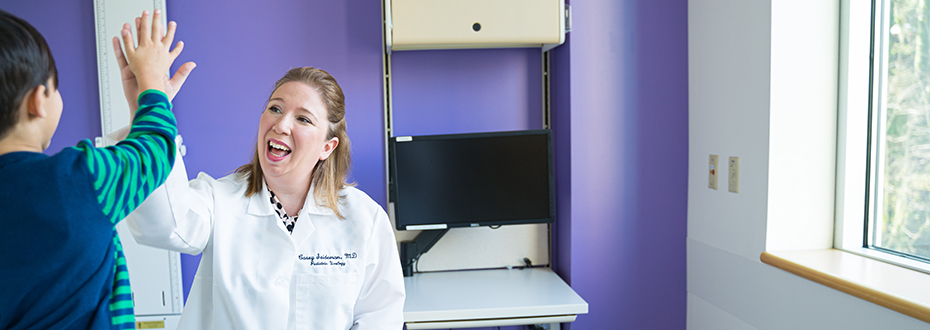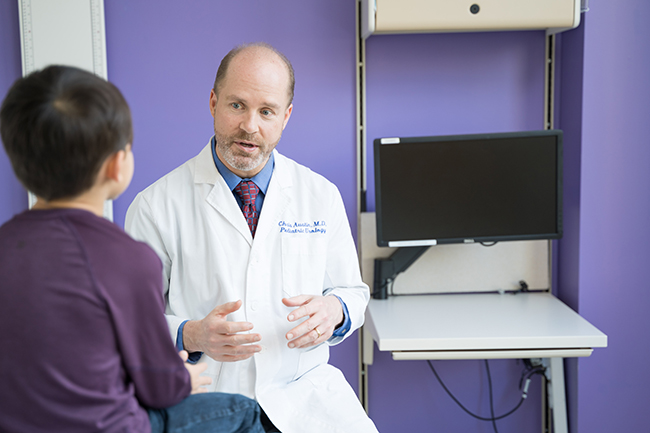Pediatric Urology Tests

OHSU Doernbecher Children’s Hospital uses the latest techniques to diagnose your child’s condition. We know these tests may seem scary for your child. We schedule them in advance, and we explain what to expect to you and your child. In most cases, you can be with your child during the entire test.
Our excellence
Safer imaging: We participate in the Image Gently national campaign to reduce children’s radiation exposure during imaging. We take care to use only the tests and exposure needed.
Advanced technology: We offer a test that uses video to assess severe urinary disorders. We also use an uncommon MRI (magnetic resonance imaging) scan that can show how the urinary system is working.
Types of tests
What it is: An MRI scan uses strong magnets and radio waves to make detailed images of tissues inside your child’s body. We’re one of the region’s few hospitals that uses an MRI designed to examine the urinary system.
What to expect: Your child will lie still on a table that slides inside a tunnel. Some children need sedation to help them relax. Before some MRIs, a contrast fluid is injected into your child’s urinary system through a catheter (thin flexible tube).
What it is: A special camera takes pictures of the kidneys after a weak radioactive solution is injected into your child’s blood. This checks for kidney scarring or damage.
What to expect: A solution called DMSA (dimercaptosuccinic acid) is given through an IV. Your child can play and relax as the solution travels to the kidneys over three to four hours. The camera then records the solution’s progress through the kidneys over about 30 to 45 minutes. Your child will need to lie still and may need sedation. You’ll have early results in half a day and a final report in about two days.
What it is: A special camera takes photos of the kidneys after a weak radioactive solution is placed in the bloodstream. This measures kidney function.
What to expect: Younger children need sedation. A solution, called Mag3 for short, is given through an IV. A catheter may be put in the bladder to drain urine during the test. A special camera takes photos of the kidneys about every 20 minutes for one or two hours. The IV then delivers a medication called Lasix that causes the kidneys to quickly produce more urine. More images are taken. Results are often available right away.
What it is: Sound waves make images of the kidneys, bladder and the ureters (tubes) that connect them. This test can check for:
- Injuries
- Abnormalities
- Blockages or kidney stones
- Urinary tract complications, such as kidney damage or urethra narrowing
- Cysts or tumors
What to expect: Warm gel is put on your child’s belly. A provider moves a wand over the belly, showing images of internal organs on a computer screen. Your child may be asked to use the restroom to urinate before more images are taken.
What it is: A VCUG test X-rays the bladder when it's full and when it's emptying to see how the urinary tract is working.
What to expect: A catheter is put through the urethra into the bladder while your child lies on an X-ray table. Contrast dye is injected through this thin tube, and your child's bladder is X-rayed in various positions. The catheter is removed so your child can urinate. More X-rays are taken of the bladder and urethra during urination. The test takes about 45 minutes. Results are available right away. Younger children can be sedated.
About your child’s VCUG: What to expect and how to get ready
We offer the only video urodynamics evaluation for children in Oregon. This is the most advanced test for children with severe bladder dysfunction.
This test may be recommended if your child:
- Needs to urinate frequently or urgently.
- Leaks urine.
- Wets the bed.
- Doesn’t completely empty his bladder.
- Lacks bladder control because of nerve problems.
What it is: This exam combines pressure testing, electromyelogram testing and a real-time X-ray machine called a fluoroscope. It checks your child’s bladder, sphincter and urethra from all angles to see how they’re working.
What to expect: A catheter is inserted through your child’s urethra into his bladder. The bladder is filled with dye, and a small balloon is put in his rectum to check pressure. These may be uncomfortable, and we can offer sedation if needed.
Electrodes are attached with adhesive to your child’s buttocks to evaluate muscles. The fluoroscope takes moving images of the bladder while it’s full and when your child urinates. This test may take an hour.
Afterward, your child may have a slight burning sensation or small amount of blood when urinating. This usually goes away within a day. The results are usually available within a few days. Your child may need one or more tests.
What it is: Uroflow measures how much urine is in the bladder, how fast urine comes out and how long it takes your child to urinate. Your child will urinate into a portable toilet connected to a computer.
What to expect: Give your child plenty to drink about an hour before the test to make sure the bladder is full. Your child may sit or stand while urinating. Adhesive sensors are attached near your child’s urethra (the opening where urine leaves the body). Your child will be asked to tighten and relax muscles, and a computer will record how well they work. This test may last up to an hour. You may get some results right away, others after several days.

What if my child needs sedation?
If your child needs or may need sedation, follow our pre-surgery guidelines on limiting food and drink. This will protect your child’s safety and avoid having to postpone the test.
For families
Call 503-346-0640 to:
- Request an appointment.
- Seek a second opinion.
- Ask questions.
Locations
Parking is free for patients and their visitors.
Doernbecher Children’s Hospital
700 S.W. Campus Drive
Portland, OR 97239
Map and directions
We also offer locations in Eugene and Salem.
Refer a patient
- Refer your patient to Doernbecher.
- Call 503-346-0644 to seek provider-to-provider advice.